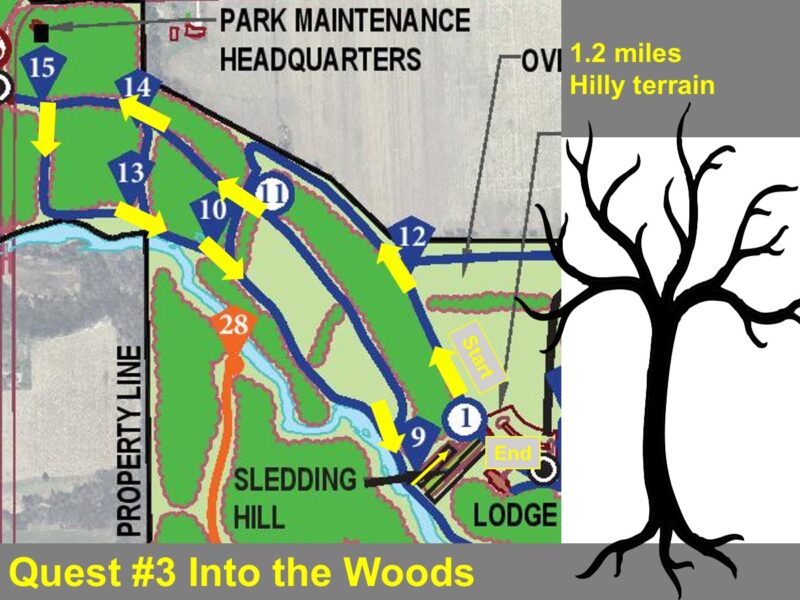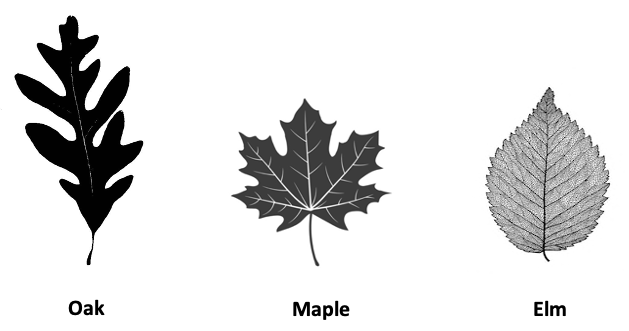OptOutside Quest 3

Quest #3 – Into the Woods
Hills, 1.2 miles, some uneven terrain. The numbers correspond with the numbers on the wooden posts along trail and on the map attached. You will also see additional blue arrows along the way to keep you on the right path.
Did you know that trees can tell the story of what is happening beneath your feet? Some trees prefer wet soils while others need to keep their feet dry. Some trees can even change the soil to meet their needs and discourage the growth of others. This quest will take you on a longer journey through Columbus County Park as you learn to identify trees and woody shrubs and discover how plants can tell a story about the landscape. How do you think people, animals and other plants benefit from trees?
START: #1 – Trees From Afar
From this vantage point, it is easy to see the shapes of individual trees in the distance. Some trees can be identified by their overall silhouette. In a forest, that may not always be possible as trees often grow straighter and thinner as a result of competition. In an open field trees growing in the absence of competition tend to develop their characteristic crown shape. Oak trees growing on their own will often have thick trunks with branches that start close to the ground, making them excellent for climbing. Elms tend to have an overall vase shape and the trunks often split in a V near the bottom. Maple trees growing on their own tend to have a straight single trunk, with branches that begin about halfway up; their crowns may be rounded or get narrow towards the top. Many trees can be identified by their leaves, which at this time of year are mostly on the ground. Can you find oak, maple and elm as you walk today?

Learning to recognize trees can help us understand the landscape as a whole. As you will learn during this quest today, some trees are more common near water while others prefer dryer, upland soils. Imagine explorers hundreds of years ago spotting species like cottonwood, sycamore and willow from a distance and knowing that water may be nearby. Likewise, a stand of white oaks is an indicator of drier conditions. Why do you think having this skill might be useful?
#12 – Old Farm Lane
Many of the trees lining the path to your right were intentionally planted 90 years ago when this property was a working farm. These Siberian Elms were most likely chosen due to their rapid growth and resistance to Dutch Elm Disease, which was an emerging concern in the early 1930s. It is estimated that 75% of the Unites State’s native elm trees were lost to Dutch Elm Disease between 1930 and 1989. Unfortunately, Siberian Elms are considered by ecologists as invasive, meaning they are not native, spread aggressively, and can cause harm to the environment. Their wind-blown seeds tend to form thick stands of young trees with little diversity. Here in Columbus County Park, the staff regularly mows this area to prevent these stands from establishing.
As you walk to the next stop, look to your left. You will notice many tall dark trunks that all resemble each other. This is a stand of black locust trees. Black Locust is an invasive tree that was intentionally planted in Michigan in the late 1800s. Black Locust grow rapidly, produce seeds after just a few years and also spread by producing clones that sprout from their roots. Black Locust trees are allelopathic, meaning they exude substances from their roots that can inhibit the growth of other plants. Many of our native trees cannot tolerate these conditions. The native Black Cherry tree is one that is tolerant of Black Locust allelopathy. Black Cherry has dark colored, flaky bark that some people think resembles burnt potato chips stuck to the tree trunk. Can you spot these trees growing among the Black Locusts?
#11 – Identification Basics
Once you make the turn to your right, the single tree you see on your left just ahead is a willow. When learning to identify trees, it is a good idea to recognize a few key parts. In addition to overall shape, trees can often be identified by their leaves, buds, twigs, and bark. The typical identifying features of the willow include leaves that are 3-6” long and ½” wide. The leaves are dark green on the top side, with a very light green to white underside. During the winter, some willows can be recognized by their golden yellow twigs.
#14 – Succession
As you head into the thicker forest, what changes do you observe? The field you just left is managed and mowed every few years. If it was not, eventually it would look like the forest you are about to enter. The process of succession involves the gradual and natural replacement of species as shade, soil conditions and moisture availability change. Most of Columbus County Park has been logged at least once in the past 100 years. The forest in front of you is an example of a secondary growth forest. It has been left to grow with little management and the impacts of human disturbance are not as evident.
As you move to the next stop, observe the trees that you pass. Look to both sides of the path and up ahead of you. To your right, you will notice more coniferous, or evergreen, trees. Most Michigan’s conifer species prefer well drained soils, which are more typical of the upland parts of the park.
#15 – Powerline Cut
The first part of this trail is part of a powerline cut, an example of how human activity can alter growing conditions for plants and trees. The continuously maintained cut creates edges that are ideal for some species but also encourages encroachment by unwanted plants, such as Poison Ivy and invasive Multiflora Rose.
#13 – Trees, People and Wildlife
Across the river you can see the distinctive drooping shape of a willow tree. Most willow trees like to “have their feet wet” and can often be found near water. Roots of willow trees can spread up to three times further than the crown of the tree and are often responsible for clogging older drainage tile systems, septic tanks and storm drains. Willow bark has long been known as a source of pain relief. While now chemically produced in a lab, the active ingredient in aspirin, salicin, was first isolated from willow bark in 1829. Turn around and look across the field behind you, see if you can spot the large White Oak growing on its own.
While live trees are important to the wildlife that inhabits this park, the dead trees also offer a source of food and shelter. Dead trees that are still standing, called snags, provide homes for owls, bats, raccoons and opossums. Woodpeckers come to feed on the bugs that live in the trunk and fungus will grow and allow the tree to decompose. Dead trees lying on the ground are called logs. Logs provide shelter for ground dwelling mammals, like rabbits and chipmunks. Many small amphibians and reptiles, like salamanders and snakes, find shelter under logs. Eventually, the logs will decompose and their nutrients will be returned to the soil.
#10 – Cottonwoods
Cottonwoods are another species that likes wet soil conditions. You can identify them by their tall, straight, trunks that branch near the top. The bark is gray in color with deep furrows but appears lighter at the top. The yellow or brown triangle or D-shaped leaves at your feet came from this tree. Pick one up and hold it by the stem (also called a petiole), you will notice that because of the long petiole, just the slightest breeze will make this leaf move. Cottonwoods seeds are dispersed by the wind; this is the tree that can make it appear to be “snowing” on a warm summer day.
As you move on to the last stop, observe the trees and grasses you see across the river. You may notice they look different than the trees directly around you. Why do you think they are different?
END: #9 – Japanese Barberry
The shrubs you see around you dotted with red berries are Japanese Barberry. Barberries are an invasive shrub that was commonly used as a landscaping plant. It easily escapes cultivation as seeds are spread by birds and other wildlife. It forms thick stands and the leaves are not browsed by wildlife due to the numerous thorns. This gives it a competitive edge over native plants. Japanese Barberry can also alter soil conditions, making unsuitable for other plants. Interested in finding out how you can help control invasive species?
